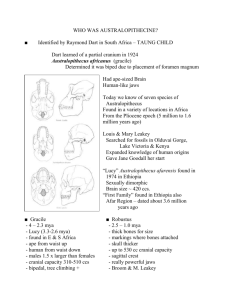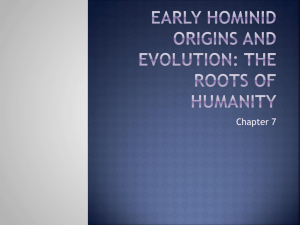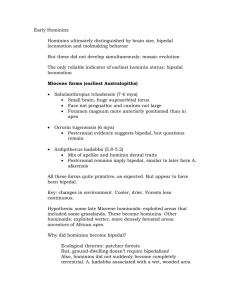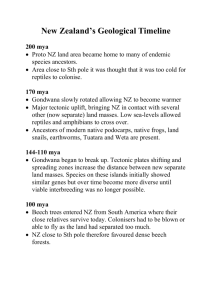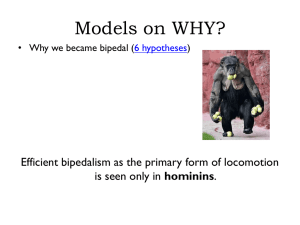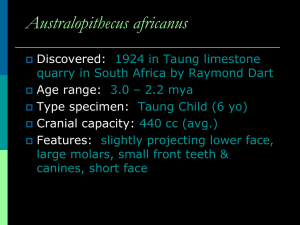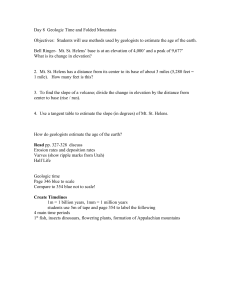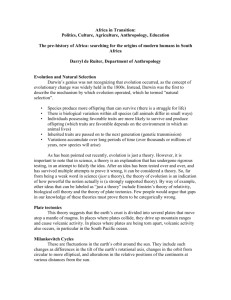Chapter 10 notes
advertisement
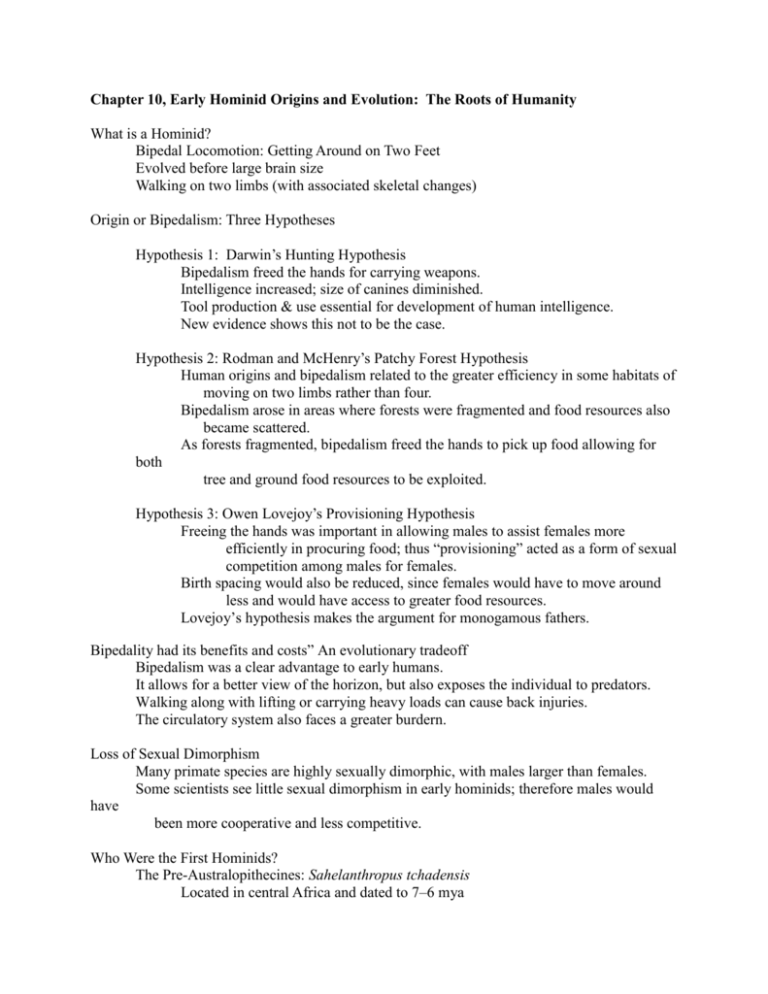
Chapter 10, Early Hominid Origins and Evolution: The Roots of Humanity What is a Hominid? Bipedal Locomotion: Getting Around on Two Feet Evolved before large brain size Walking on two limbs (with associated skeletal changes) Origin or Bipedalism: Three Hypotheses Hypothesis 1: Darwin’s Hunting Hypothesis Bipedalism freed the hands for carrying weapons. Intelligence increased; size of canines diminished. Tool production & use essential for development of human intelligence. New evidence shows this not to be the case. Hypothesis 2: Rodman and McHenry’s Patchy Forest Hypothesis Human origins and bipedalism related to the greater efficiency in some habitats of moving on two limbs rather than four. Bipedalism arose in areas where forests were fragmented and food resources also became scattered. As forests fragmented, bipedalism freed the hands to pick up food allowing for both tree and ground food resources to be exploited. Hypothesis 3: Owen Lovejoy’s Provisioning Hypothesis Freeing the hands was important in allowing males to assist females more efficiently in procuring food; thus “provisioning” acted as a form of sexual competition among males for females. Birth spacing would also be reduced, since females would have to move around less and would have access to greater food resources. Lovejoy’s hypothesis makes the argument for monogamous fathers. Bipedality had its benefits and costs” An evolutionary tradeoff Bipedalism was a clear advantage to early humans. It allows for a better view of the horizon, but also exposes the individual to predators. Walking along with lifting or carrying heavy loads can cause back injuries. The circulatory system also faces a greater burdern. Loss of Sexual Dimorphism Many primate species are highly sexually dimorphic, with males larger than females. Some scientists see little sexual dimorphism in early hominids; therefore males would have been more cooperative and less competitive. Who Were the First Hominids? The Pre-Australopithecines: Sahelanthropus tchadensis Located in central Africa and dated to 7–6 mya Brain size (cranial capacity) of 350 cc Foramen magnum indicative of likely bipedality Non-honing chewing complex Close to pongid/hominid divergence The Pre-Australopithecines: Orrorin tugenensis Located near Lake Turkana and dated to 6 mya Femurs indicative of bipedalism Curved hand phalanx, suggesting time spent in trees Nonhoning chewing complex Lived in a forest The Pre-Australopithecines: Ardipithecus kadabba and Ardipithecus ramidus Located at Aramis and dated to 5.8–4.4 mya Partial skeleton, other bones, and teeth Variation in tooth wear; possessed thin enamel Lived in a forest Time spent on ground and in trees The Pre-Australopithecines” Australopithecus anamensis Located at Lake Turkana and Ethiopia and dated to 4 mya Physically somewhat similar to Ardipithecus Large canines, parallel tooth rows, different cusp pattern on lower first premolar The Australopithecines (4–1 mya) : Australopithecus afarensis (3.6–3.0 mya) Located in Laetoli and Hadar (found first in Hadar) and dated to 3.6–3.0 mya Lucy (type specimen) is very complete for the age, 40 percent of skeleton found Bipedal but with shorter legs, resulting in a slightly different stride Long arms, curved finger bones, suggesting tree use Cranial capacity of 430 cc At Laetoli, assemblages include hominids as well as footprints of three hominids Lived in varied habitats The Australopithecines (4–1 mya): Australopithecus (Kenyanthropus) platyops (3.5 mya) Found at Lake Turkana and dated to 3.5 mya Woodland habitat Flat face with some primitive characteristics Evolution and Extinction of the Australo-pithecines: Australopithecus aethiopicus and Australopithecus boisei Found in several locations in Africa A. aethiopicus dates to 2.5 mya and had a cranial capacity of 410 cc A. boisei dates to 2.3–1.2 mya and had a cranial capacity of 510 cc Smaller front teeth, larger back teeth Sagittal crest for attachment of chewing muscles Dietary focus on harder foods Evolutionary dead end Evolution and Extinction of the Australo-pithecines: Australopithecus africanus Found at Taung, South Africa and other sites, dating to 3–2 mya Larger teeth than A. afarensis Brain size of 450 cc Evolution and Extinction of the Australopithecines: Australopithecus robustus Found in South Africa and dated to 2 mya Large premolars and molars, with a large face and sagittal crest Similar to East African forms Brain size of 530 cc Australopithecus garhi (2.5 mya): First Maker and User of Tools Located in Ethiopia and dated to 2.5 mya Bones, teeth, partial skeleton, and a skull Larger teeth than earlier australopithecines More humanlike humerus-to-femur ratio Cranial capacity of 450 cc Probable ancestor of Homo Associated mammal bones with cutmarks, leading to conclusion that A. garhi made Oldowan tools, the earliest stone tools. Stone tools long associated with meat consumption; some wear may indicate tools were also used for digging in ground.
